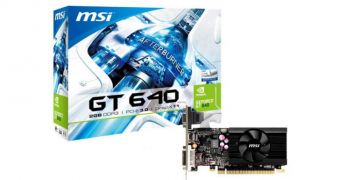Like AMD's Eyefinity technology, NVIDIA's 3-display 3D Vision surround is normally advertised as a means to enrich the gaming experience. Seldom is any other use touched upon.
MSI is emphasizing a less known advantage of multi-monitor configurations: three displays means three times the workspace available for spreadsheets, database browsers, etc. Essentially, multi-display setups enrich productivity.
Thus, even low-end video cards can be used in this type of scenario. It is one of the few things enabling them to still sell actually.
A couple of years ago, there were plenty of buyers for low-end add-in graphics adapters. Now, though, both Intel and AMD are selling processors with decent, or good in the latter's case, graphics chips.
The normal customer channels NVIDIA had are now closed. Only special-purpose video controllers have any chance of shipping now.
That said, the MSI low profile GeForce GT 640 uses a GK107 graphics processing unit whose clock frequency is of 900 MHz. It has 384 CUDA cores.
2 GB of VRAM back the chip up. It is of the DDR3 variety, so the speed is of 1,792 MHz. An interface of 128 bits connects the GPU to the memory and vice versa.
Besides the video ports, these are all the details that prospective buyers need in order to make up their minds in regard to whether or not this board (model: N640GT-MD2GD3/LP) is the best suited for them.
Speaking of which, a dual-link DVI is available, alongside a D-Sub port and an HDMI connector.
Micro-Star International slapped a single-slot, single-fan cooler, and a price of $90 on the GeForce GT 640. That means either 70 Euro (according to exchange rates) or 90 Euro (according to the normal IT market developments, where items sold in the US sell for as many Euro on the old continent).
Sales should begin soon. In the meantime, those interested may as well look for some monitors with thin bezels.

 14 DAY TRIAL //
14 DAY TRIAL //